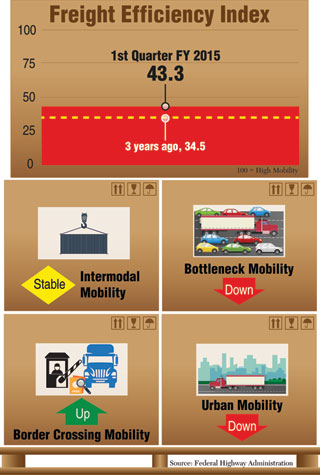Researchers Target Human Factors
WASHINGTON — As funding constraints limit construction of new roads and bridges, transportation researchers are devoting less time and money on studies of pavement design and more on human factors, such as driver fatigue, to reduce crashes and improve the performance of the nation’s highways.

Research also is moving away from pure academic studies and toward real-world experimentation and collaborative projects, such as the Mcity test site at the University of Michigan, where technology for connected and automated vehicle systems is being evaluated in a simulated urban environment.
At a meeting of the Truck and Bus Safety Research Committee at the Transportation Research Board annual meeting here, research coordinator Ron Knipling presented no less than 55 research and development needs organized into 11 categories, one of which was roadway design and operation. Other areas included problem assessment and data, regulation, enforcement and compliance, driver health and wellness, driver human factors, carrier safety management, training and vehicle design and technology.
In addition, representatives of several federal transportation agencies presented lists of projects they are pursuing, with even more coming as a consequence of mandates in the FAST Act, legislation recently enacted into law that provides funding for highways and mass transit for the next five years.
Nicole Katsikides, from the Federal Highway Administration Office of Freight Management and Operations, said the law contains money for development of new data sources to help streamline freight movement.
“By understanding the trip goods make, we can identify bottlenecks and then convince decision-makers where to spend money,” she said. “Our goal is to help states understand freight.”
Katsikides said she also is trying to revive the Vehicle Inventory and Use Survey, which was last completed in 2002. She also would like to emulate a system in Canada in which data are collected directly from drivers instead of through surveys to determine where freight is moving on highways.
An example of how data can be used is FHWA’s Freight Efficiency Index, where data on truck speed and traffic flow are used to assess freight mobility. The index looks at intermodal mobility, bottleneck mobility, border-crossing mobility and urban mobility.
The index is published quarterly, and the latest reading for the first quarter of the government’s 2015 fiscal year ended Dec. 31, 2014, was 43.3 on a scale of zero to 100, with 100 indicating high mobility. The index showed improvement from 35.8 in the same period in the prior year.
Meanwhile, the Federal Motor Carrier Safety Administration listed 44 active research projects, looking at everything from driver fatigue to roadside technology and a study of driver training in Mexico.
Martin Walker, chief of research for FMCSA, said the agency has two goals for research. One is outreach to help drivers and companies operate more safely. The other is to support the agency’s regulatory mission.
Among the research topics pursued in 2015, Walker noted, were reports on the safety issues in the Bakken oil region, the use of eye-glance analysis to detect driver fatigue, the effectiveness of driver simulators to reduce distracted driving and recommendations on how to reduce pedestrian and bicycle crashes involving large trucks.
Recent investigations by the National Transportation Safety Board underscore the need for additional research to improve truck safety, Robert Molloy, deputy director of the agency, said in his presentation at the TRB meeting.
In one case, a fatigued truck driver hit the back of a limousine that had slowed in a construction zone. It was learned that the driver had commuted from a long distance before starting his shift behind the wheel, creating a situation not unlike when pilots get insufficient rest before starting their shift, Molloy said.
Another crash in Oklahoma was caused by a truck driver who passed out behind the wheel and later admitted to investigators that he was taking synthetic drugs that could not be detected by current drug and alcohol tests.
Another example of new research is the Smart City Challenge, a program launched in December by U.S. Transportation Secretary Anthony Foxx, in which up to $40 million will be awarded to one midsize city as a means of demonstrating how technology can be used to improve safety, reduce carbon emissions and enhance mobility.
Foxx said the nation’s infrastructure is not equipped to deal with a dramatically growing population in some regions around the country, and he expects the competition to generate ideas that will shape how people and goods move in the future.

